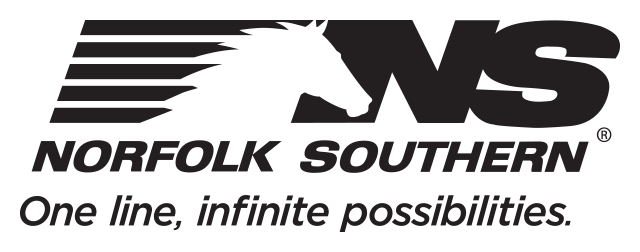Norfolk Southern: Stretching to Reduce Emissions
In 2010, Norfolk Southern set an ambitious five-year goal to reduce greenhouse gas emissions by 10 percent for every revenue ton-mile of freight our trains transport. In 2014, the final year, the company reduced emissions 8.5 percent per revenue ton-mile, or 85 percent of the goal.
Over the period, the company achieved substantial reductions in business emissions. In 2014, the railroad moved 205 billion revenue ton-miles of freight, meaning that emissions avoided through the 8.5 percent reduction totaled roughly 524,800 metric tons of GHG annually. That’s equivalent to removing more than 110,480 gas-burning passenger vehicles from the highway, according to a U.S. Environmental Protection Agency emissions calculator.
Norfolk Southern raised the bar high for our reduction goal, concluding that it would be better to stretch and fall short than hit an easy target. Reductions achieved are attributed largely to improvements in locomotive fuel economy and energy efficiencies of railroad offices, shops, and yards.
The company’s goal was based on a 2009 GHG intensity rate of 30 grams of CO2-equivalent emissions per revenue ton-mile. In 2014, the ton-mile emissions rate from all operations — including locomotives, non-locomotive fossil fuel burn, and facility energy usage — was down to 27.4 grams. To hit the goal, the railroad needed to lower emissions to 27 grams.
In 2015, the company plans to set a new longer-term emissions goal.
2014 Carbon Footprint
In 2014, Norfolk Southern generated 5.6 million metric tons of greenhouse gases from business operations. Diesel-burning locomotives accounted for 90 percent of total emissions, or 5 million metric tons. Emissions generated from use of purchased power to heat, cool, and light railroad facilities accounted for 5 percent of the total. The remaining 5 percent was generated mostly by a mix of fossil fuels used in business operations.
While business growth drove up emissions, the railroad contributes to an overall reduction in U.S. greenhouse gases when shippers use rail instead of the highway. Because trains on average are four times more fuel efficient than trucks and reduce GHG emissions by 75 percent, overall emissions would have been greater if the freight had moved by truck.
Norfolk Southern aspires to absolute reductions of CO2, but a small increase in rail emissions from business growth that results from taking freight off interstate highways comes with a silver lining - transportation that is cleaner and greener.
The Green Machine: How Shippers Can Reduce Their Footprint
Norfolk Southern offers an easy way for shippers to calculate how they can reduce supply-chain emissions by moving their goods by rail.
The company’s carbon footprint analyzer - the “Green Machine” - enables shippers to compare greenhouse gas emissions of intermodal and rail versus truck over specific routes. The calculator is accessible on Norfolk Southern’s website.
Using the calculator, shippers can enter data, including cargo tonnage and origin and destination points, to quickly compare the environmental benefits of using rail vs. highway. The calculator uses industry averages of locomotive and truck fuel efficiencies based on studies by the Federal Railroad Administration. On average, trains are four times more fuel efficient than trucks and generate 75 percent fewer emissions.




